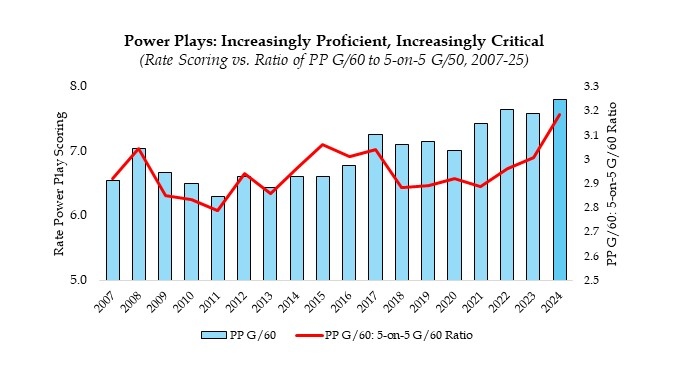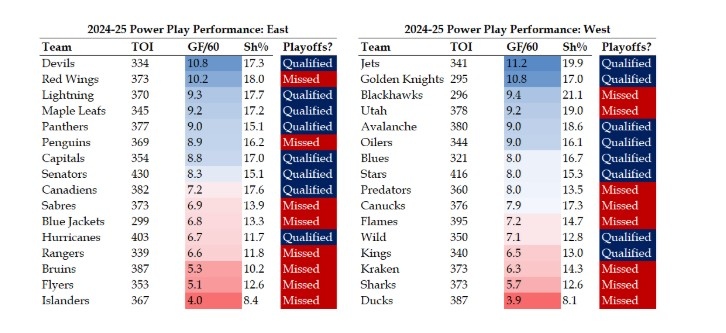7h ago
Power plays continue to rule the day in the NHL
In the NHL’s offensive renaissance, hallmarked by a boom in both even-strength scoring and power-play scoring, has made power-play performance a meaningful differentiator between playoff contenders and pretenders, Travis Yost writes
By Travis Yost
If you want to make the National Hockey League playoffs, a productive power play is now essential.
One of the most important shifts the league has realized in recent years concerns the importance of the power play. In years past, especially during periods where league-wide scoring was deflated (think 2010-17, where teams averaged just about 2.6 goals per game), power-play scoring was something of a luxury.
But the NHL’s offensive renaissance, hallmarked by a boom in both even-strength scoring and power-play scoring, has made power-play performance a meaningful differentiator between playoff contenders and pretenders. Last summer we discussed how notable the shift was, and the 2024-25 regular season further entrenched this point.
While even-strength scoring cooled a bit last year, the power play did not – rate-goal scoring there hit a new modern era high, with the average unit scoring 7.8 goals per 60 minutes on the man advantage.
There are undoubtedly several contributing factors to this (four-forward deployment strategies, an influx of offensive skill at both the forward and defensive positions league-wide, deadly superstar groups on several teams around the league), but the trend speaks for itself:

I homed in on last season because it’s the first time in a while we have seen a scoring divergence – even strength slowing marginally, but the power play continuing to rise. The latter rise came despite notable year-over-year drop-off from two teams that have been reliable contributors on this front – the Tampa Bay Lightning and Edmonton Oilers have carried the two deadliest power-play units for some time now, and yet both saw a substantial relative decline last season (-21 per cent and -15 per cent, respectively).
But there’s little mistaking the importance of a great power play. Unless your team is uniquely great at even strength (a la the Carolina Hurricanes and Los Angeles Kings), or uniquely terrible at even strength (the Chicago Blackhawks and Detroit Red Wings), performance here did have a major impact on playoff qualification:

If you factor in goals conceded on the power play (shorthanded goals for the opposition), only one team in the bottom 10 in power-play net goals qualified for the playoffs, that being the aforementioned Kings. It’s a shocking change when you compare it to where this league was a decade ago.
Using the 2014-15 season as a parallel, six of the league’s bottom 10 teams in power play performance qualified for the postseason, including three of the four divisional champs:
- 21st-ranked Chicago Blackhawks (6.1 goals per 60)
- 23rd-ranked Montreal Canadiens (5.8 goals per 60)
- 24th-ranked New York Rangers (5.7 goals per 60)
- 25th-ranked Anaheim Ducks (5.7 goals per 60)
- 26th-ranked Nashville Predators (5.6 goals per 60)
- 28th-ranked Minnesota Wild (5.4 goals per 60)
How were last season’s Kings able to overcome the odds and reach the playoffs, scoring at a rate where just about every other club missed the playoff cutline by a considerable margin? They offset those man-advantage woes by carrying an absurd +47 goal differential at even strength, second only to the Presidents’ Trophy-winning Winnipeg Jets. Add a fifth-ranked penalty-kill unit (6.5 goals per 60 against) on top of that, and you have a recipe that can offset some of those scoring challenges.
But being great everywhere else is a difficult ask for any team in the league. It’s also why I wrote last week I was surprised to see a player like forward Victor Olofsson still a free agent on the hunt for his next team. He’s not a complete attacker by any means, but with his shooting ability and persistent ability to score on the power play in previous stops with Buffalo and Vegas, you’d have to think he’d improve many units around the league.
At any rate, it’s a statistical shift worth keeping in mind as we barrel towards the regular season. Teams can’t afford to have slumping or shoddy power plays now, and the teams investing in those minutes from both a personnel and strategy vantage point stand to reap the benefits.
Data via Natural Stat Trick, NHL.com. Evolving Hockey

